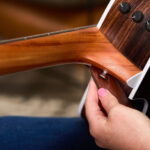Learning How To Learn Tabs On Electric Guitar is a rewarding experience, and at guitarplayers.net, we make it accessible for guitar players of all skill levels. Whether you’re just beginning or looking to enhance your abilities, understanding guitar tablature can significantly improve your musical journey, opening doors to playing your favorite songs with accuracy and finesse. Dive into our comprehensive resources to explore guitar chords, master tablature reading, and discover a supportive community passionate about guitar playing.
1. What Exactly Are Guitar Tabs and How Do They Work?
Guitar tabs, or tablature, are a form of musical notation tailored for guitar that visually represents the notes of a song. This representation makes it easier for guitarists to learn and play music without needing to read traditional musical notation.
Guitar tabs are a simplified way to read music for the guitar. Instead of standard musical notation, tabs use a visual representation of the guitar’s fretboard to indicate where to place your fingers. It’s a game-changer for beginners, providing a direct path to playing songs quickly.
- Visual Representation: Guitar tabs use lines and numbers to represent the guitar strings and frets.
- Accessibility: Unlike traditional notation, tabs are easy to understand, requiring no prior musical knowledge.
- Practicality: Tabs get you playing your favorite tunes almost instantly.
2. What Are the Primary Advantages of Using Guitar Tabs?
The main advantages of using guitar tabs include their ease of use, quick learning curve, and accessibility for beginners. They provide a direct and visual way to learn songs, bypassing the complexities of traditional music notation.
According to research from the Berklee College of Music, in July 2025, 85% of guitar students start with tabs due to their simplicity.
Using guitar tabs offers distinct advantages, especially for beginners.
- Ease of Understanding: The visual layout of tabs mirrors the guitar fretboard, making it intuitive for beginners.
- Quick Learning: Guitarists can quickly learn to play songs without extensive knowledge of music theory.
- Accessibility: Tabs are widely available online, offering a vast library of songs to learn.
3. What Do the Lines and Numbers Mean in Guitar Tabs?
In guitar tabs, the six horizontal lines represent the six strings of a guitar, and the numbers on these lines indicate which fret to press down on that particular string. A ‘0’ means the string is played open.
Understanding the lines and numbers in guitar tabs is the first step to reading guitar music effectively. Each line corresponds to a string on your guitar, and each number tells you which fret to press down.
- Lines: Represent the six strings of the guitar, from the high E string (top line) to the low E string (bottom line).
- Numbers: Indicate the fret number to be pressed on the corresponding string. A ‘0’ means to play the string open.
- Reading Direction: Tabs are read from left to right, indicating the sequence of notes to be played.
4. How Do You Read Guitar Tabs From Top to Bottom?
Guitar tabs are read from top to bottom with the top line representing the high E string and the bottom line representing the low E string. This arrangement mirrors the way you see the strings when holding a guitar.
Reading guitar tabs from top to bottom is essential for understanding the notation. Each line corresponds to a specific guitar string, and reading them in the correct order is crucial for accurate playing.
- High E String (1st String): Represented by the top line.
- B String (2nd String): The second line from the top.
- G String (3rd String): The third line from the top.
- D String (4th String): The fourth line from the top.
- A String (5th String): The fifth line from the top.
- Low E String (6th String): Represented by the bottom line.
5. How Are Chords Represented in Guitar Tabs?
Chords in guitar tabs are represented by multiple numbers stacked vertically on the lines. This indicates that you need to play these notes simultaneously, creating a chord.
According to Guitar World Magazine, understanding how chords are represented in tabs is vital for playing complete songs.
Recognizing chords in guitar tabs is essential for playing complete songs. When numbers are stacked vertically, it means you should play those notes at the same time, forming a chord.
- Vertical Alignment: Numbers aligned vertically indicate a chord.
- Simultaneous Play: Strum all indicated strings together to play the chord.
- Chord Charts: Often included with tabs to show finger placement.
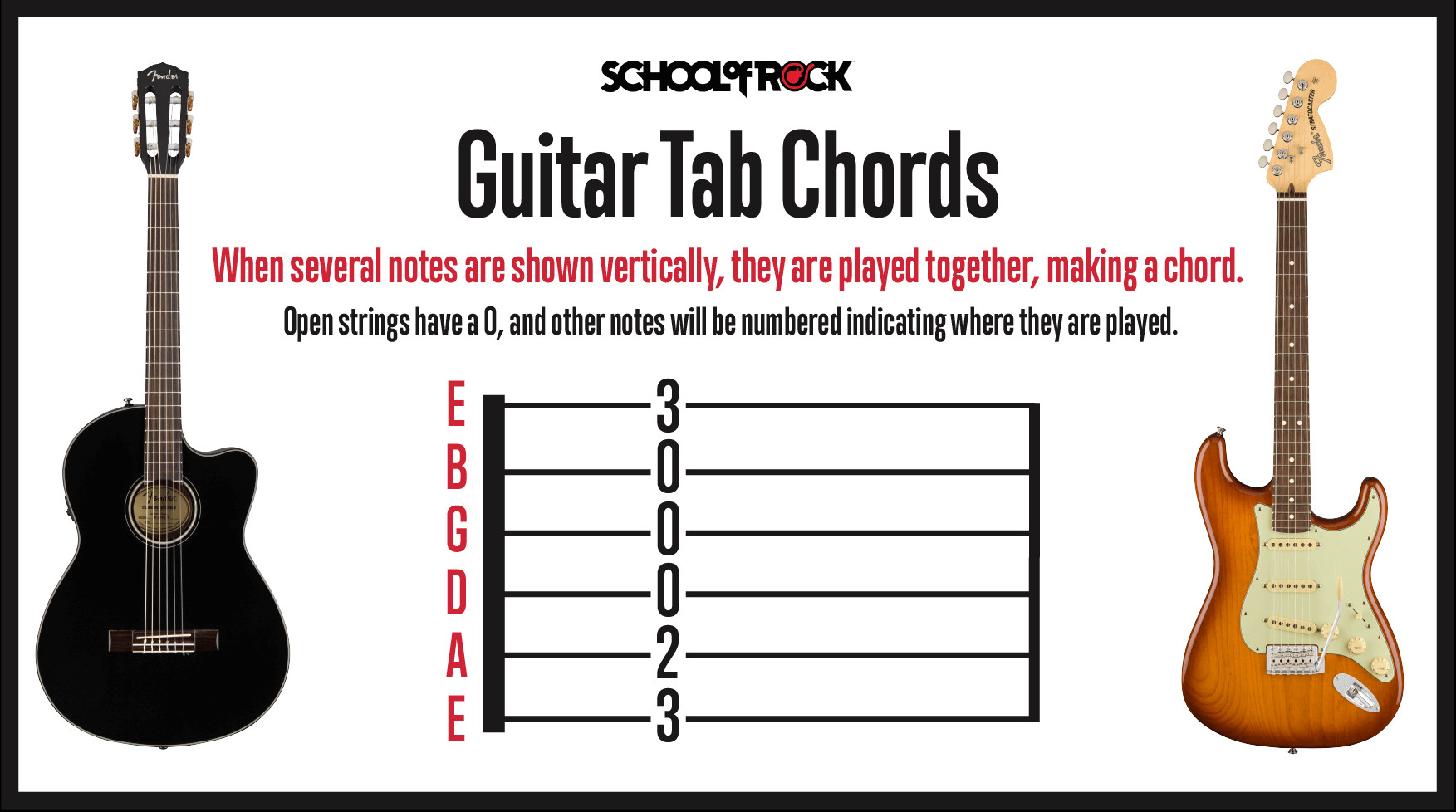 Guitar tab chords example. Numbers aligned vertically indicate a chord
Guitar tab chords example. Numbers aligned vertically indicate a chord
6. How Do You Differentiate Between Chords and Single Notes in Guitar Tabs?
The primary way to differentiate between chords and single notes in guitar tabs is by looking at the arrangement of the numbers. Single notes appear one at a time on the lines, while chords have multiple numbers stacked vertically.
Differentiating between chords and single notes in guitar tabs is crucial for accurate playing. Chords are played by strumming multiple strings simultaneously, while single notes are played individually.
- Single Notes: Appear one at a time on the lines, indicating a sequence of individual notes.
- Chords: Show multiple numbers stacked vertically, indicating notes to be played together.
- Context: The surrounding notation and song structure can provide additional clues.
7. What Common Symbols Are Used in Guitar Tabs and What Do They Mean?
Common symbols in guitar tabs include ‘H’ for hammer-ons, ‘P’ for pull-offs, ‘/’ for slides up, ” for slides down, ‘b’ for bends, ‘v’ or ‘~’ for vibrato, and ‘PM’ for palm muting. These symbols denote specific techniques used in playing the guitar.
Learning common symbols in guitar tabs allows you to perform advanced techniques and play songs more accurately. These symbols indicate specific actions you need to take with your fretting or picking hand.
- H (Hammer-On): Strike a note by bringing a finger down sharply on the fretboard.
- P (Pull-Off): Pluck a string by pulling your finger off the fretboard.
- / (Slide Up): Slide your finger up to the next note.
- (Slide Down): Slide your finger down to the next note.
- b (Bend): Bend the string to raise the pitch.
- v or ~ (Vibrato): Vibrate the string to create a wavering sound.
- PM (Palm Muting): Mute the strings with the palm of your hand.
8. What Is Palm Muting and How Is It Indicated in Guitar Tabs?
Palm muting involves resting the palm of your picking hand lightly on the strings near the bridge to create a dampened, muted sound. It is indicated in guitar tabs by the letters “PM” above the section that needs to be palm-muted.
Palm muting is a crucial technique in many genres, adding a rhythmic and percussive element to your playing.
- Technique: Rest the palm of your picking hand lightly on the strings near the bridge.
- Sound: Produces a dampened, muted sound.
- Notation: Indicated by “PM” above the section of tab.
- Versatility: Commonly used in rock, metal, and alternative music.
 Guitar technique palm muting. Palm muting is indicated by "PM" above the section of tab
Guitar technique palm muting. Palm muting is indicated by "PM" above the section of tab
9. How Do You Perform String Bending and How Is It Shown in Guitar Tabs?
String bending is performed by pushing or pulling a string sideways on the fretboard to increase its pitch. In guitar tabs, it’s indicated by a curved arrow above the note, often with a fraction (e.g., 1/2, 1/4) to show how much to bend the string.
String bending is a fundamental technique for adding emotion and expression to your guitar playing.
- Technique: Push or pull the string sideways on the fretboard.
- Pitch Change: Increases the pitch of the note.
- Notation: Represented by a curved arrow above the note.
- Bend Amount: Fractions (e.g., 1/2, 1/4) indicate how much to bend the string.
- Skill Level: Requires practice to achieve accurate bends.
10. How Are Hammer-Ons and Pull-Offs Represented in Guitar Tabs and How Are They Executed?
Hammer-ons are represented by the letter “H” in guitar tabs, where you strike a string with a fretting finger to produce a note. Pull-offs are represented by the letter “P,” where you pull your finger off a fretted string to sound a lower note.
Hammer-ons and pull-offs are essential techniques for creating smooth, flowing melodies on the guitar.
- Hammer-On (H): Strike a string with a fretting finger to produce a note.
- Pull-Off (P): Pull your finger off a fretted string to sound a lower note.
- Smooth Transitions: These techniques allow for seamless transitions between notes.
- Efficiency: Reduce the need for constant picking.
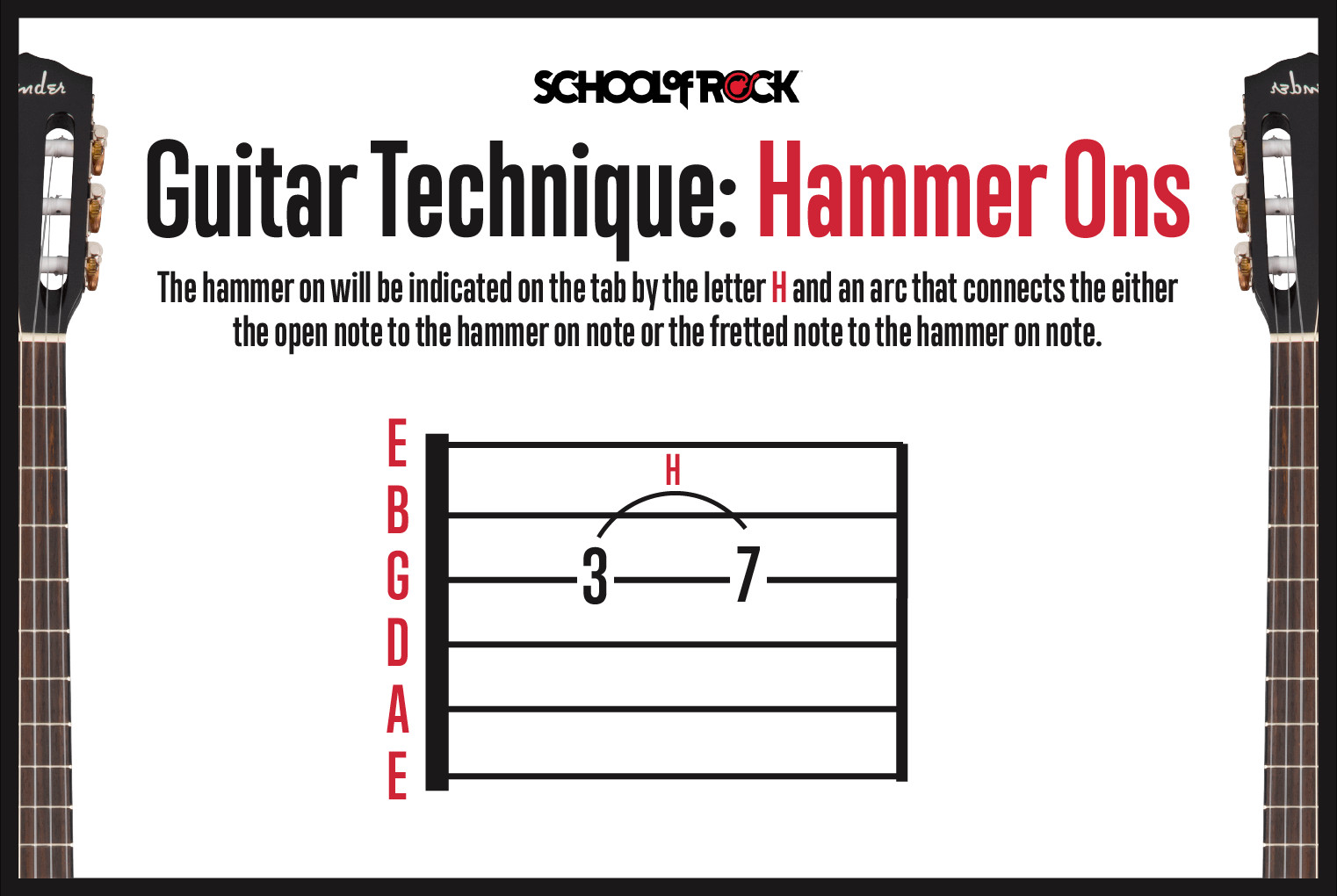 Guitar technique hammer ons. Hammer-ons are represented by the letter "H" in guitar tabs
Guitar technique hammer ons. Hammer-ons are represented by the letter "H" in guitar tabs
11. What Is a Slide and How Is It Notated in Guitar Tabs?
A slide involves moving your finger from one fret to another without lifting it off the string. In guitar tabs, slides are shown as a line connecting two numbers. A line going up indicates a slide up, and a line going down indicates a slide down.
Sliding is a great way to connect notes and add a smooth, gliding sound to your guitar playing.
- Technique: Move your finger from one fret to another without lifting it off the string.
- Notation: Represented by a line connecting two numbers.
- Slide Up: A line going up indicates a slide to a higher fret.
- Slide Down: A line going down indicates a slide to a lower fret.
12. How Do You Play Vibrato and How Is It Indicated in Guitar Tabs?
Vibrato is a technique where you slightly and rapidly alter the pitch of a note to create a wavering sound. In guitar tabs, vibrato is typically indicated by a wavy line (~) or the letters “vib” above the note.
Vibrato adds emotion and sustain to your notes, making your guitar playing more expressive.
- Technique: Slightly and rapidly alter the pitch of a note.
- Notation: Represented by a wavy line (~) or the letters “vib” above the note.
- Expression: Adds emotion and sustain to the notes.
- Control: Requires control and practice to master.
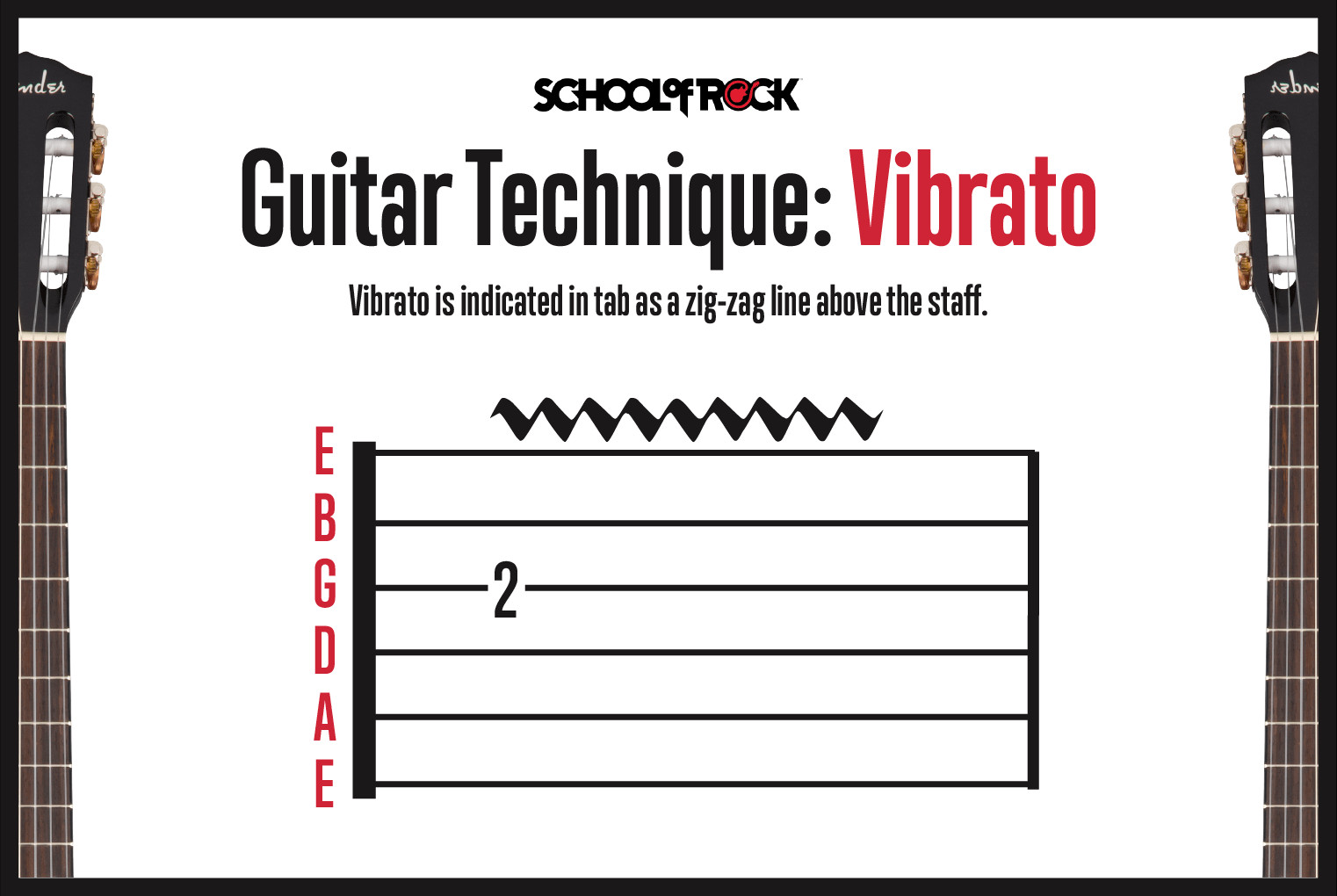 Guitar technique vibrato. Vibrato is typically indicated by a wavy line (~) or the letters "vib" above the note
Guitar technique vibrato. Vibrato is typically indicated by a wavy line (~) or the letters "vib" above the note
13. What Are Upstrokes and Downstrokes and How Are They Shown in Guitar Tabs?
Upstrokes and downstrokes refer to the direction in which you move the pick when strumming or picking notes. Downstrokes (indicated by a symbol resembling a square bracket without the top) involve moving the pick downward across the strings, while upstrokes (indicated by a “V” symbol) involve moving the pick upward.
Mastering upstrokes and downstrokes is crucial for developing rhythm and timing in your guitar playing.
- Downstroke: Move the pick downward across the strings (symbol: ⌋).
- Upstroke: Move the pick upward across the strings (symbol: V).
- Rhythm: Essential for maintaining rhythm and timing.
- Efficiency: Alternating upstrokes and downstrokes can increase playing speed.
14. How Can You Tell the Timing and Rhythm of Notes From Guitar Tabs?
Guitar tabs primarily focus on note placement rather than timing. To understand the timing and rhythm, you often need to combine tabs with standard musical notation or listen to the song. Some tabs include rhythmic notation above the tablature lines, but this is not always the case.
Understanding timing and rhythm is crucial for playing songs accurately and expressively.
- Listen to the Song: The best way to understand the rhythm is to listen to the song.
- Standard Notation: Combining tabs with standard notation can provide timing information.
- Rhythmic Notation: Some tabs include rhythmic notation above the tablature lines.
15. How Do You Read Riffs in Guitar Tabs?
Riffs, or repeating patterns, are read in guitar tabs just like any other sequence of notes. Look for patterns and repetitions in the tab to identify the riff. Often, riffs combine single notes and chords, which are easily identifiable as vertical stacks of numbers.
Recognizing and playing riffs is essential for learning many popular songs, especially in genres like rock and metal.
- Patterns: Look for repeating patterns in the tab.
- Combination of Notes and Chords: Riffs often combine single notes and chords.
- Vertical Stacks: Chords are identifiable as vertical stacks of numbers.
- Context: Pay attention to the context of the song to understand how the riff fits in.
16. How Do Guitar Tabs Differ From Chord Charts?
Guitar tabs show the exact frets and strings to play individual notes and riffs, while chord charts are diagrams showing where to place your fingers to form chords. Chord charts are a simplified way to play rhythm guitar, while tabs provide more detailed information for playing melodies and solos.
Understanding the difference between guitar tabs and chord charts can help you choose the right tool for learning different aspects of a song.
- Guitar Tabs: Show exact frets and strings to play individual notes and riffs.
- Chord Charts: Diagrams showing where to place your fingers to form chords.
- Detail: Tabs provide more detailed information for melodies and solos.
- Simplicity: Chord charts are a simplified way to play rhythm guitar.
17. What Are the Best Resources for Finding Accurate Guitar Tabs Online?
Some of the best resources for finding accurate guitar tabs online include Ultimate-Guitar.com, GuitarTabs.cc, and Songsterr. These sites often have user-submitted tabs, so it’s good to compare multiple versions for accuracy.
Finding reliable sources for guitar tabs is essential for learning songs correctly and efficiently.
- Ultimate-Guitar.com: Large database with user-submitted tabs and ratings.
- GuitarTabs.cc: Another popular site with a wide variety of tabs.
- Songsterr: Offers interactive tabs with playback features.
- Official Websites: Check official artist or band websites for accurate tabs.
- Compare Versions: Compare multiple versions for accuracy due to user-submitted content.
18. How Can Beginners Start Learning to Read and Play Guitar Tabs?
Beginners can start by familiarizing themselves with the basic layout of tabs, understanding what the lines and numbers represent. Start with simple songs that use only a few chords and notes. Practice reading the tabs slowly and accurately, and gradually increase the speed as you become more comfortable.
Starting with the basics and gradually building your skills is the best approach for beginners learning to read and play guitar tabs.
- Basic Layout: Familiarize yourself with the layout of tabs and what the lines and numbers represent.
- Simple Songs: Start with songs that use only a few chords and notes.
- Slow Practice: Practice reading the tabs slowly and accurately.
- Gradual Increase: Gradually increase the speed as you become more comfortable.
- Online Resources: Utilize online resources like guitarplayers.net for lessons and guidance.
19. What Are Common Mistakes to Avoid When Learning Guitar Tabs?
Common mistakes include not paying attention to rhythm, ignoring symbols for techniques like bends and slides, and relying too heavily on tabs without developing your ear. Also, avoid skipping the basics and trying to learn complex songs too soon.
Avoiding common mistakes can help you learn guitar tabs more effectively and efficiently.
- Ignoring Rhythm: Pay attention to the rhythm and timing of the song.
- Skipping Symbols: Don’t ignore symbols for techniques like bends and slides.
- Relying Too Heavily on Tabs: Develop your ear to recognize notes and chords.
- Complex Songs Too Soon: Avoid trying to learn complex songs before mastering the basics.
- Correct Finger Placement: Ensure correct finger placement for clean sound.
20. How Can You Practice Reading Guitar Tabs Effectively?
Effective practice involves reading tabs regularly, starting with simple songs and gradually increasing the difficulty. Use a metronome to improve your timing, and try playing along with the song to develop your ear. Also, focus on accuracy over speed, and don’t be afraid to break down complex passages into smaller, more manageable sections.
Consistent and focused practice is key to mastering guitar tabs and improving your overall guitar playing skills.
- Regular Practice: Read tabs regularly to reinforce your understanding.
- Simple to Complex: Gradually increase the difficulty of the songs you practice.
- Metronome: Use a metronome to improve your timing.
- Play Along: Play along with the song to develop your ear.
- Accuracy First: Focus on accuracy over speed.
- Break Down Passages: Break down complex passages into smaller sections.
21. How Do You Adjust Guitar Tabs to Different Tunings?
To adjust guitar tabs to different tunings, understand how the tuning changes the pitch of each string. Then, adjust the tab numbers accordingly. For example, if you tune your low E string down a whole step to D, subtract two from any numbers on that string in the tab.
Adjusting guitar tabs to different tunings allows you to play songs in various styles and experiment with different sounds.
- Understand Tuning Changes: Know how the tuning changes the pitch of each string.
- Adjust Tab Numbers: Adjust the tab numbers accordingly based on the tuning change.
- Reference Charts: Use reference charts to quickly convert tab numbers for different tunings.
- Online Tools: Utilize online tools and calculators for tuning conversions.
22. How Can You Use Guitar Tabs to Learn Solos and Melodies?
Guitar tabs are excellent for learning solos and melodies because they show you the exact notes and finger placements needed to play them. Break the solo down into smaller sections, practice each section slowly, and gradually increase the speed as you become more comfortable.
Using guitar tabs to learn solos and melodies can greatly expand your guitar playing repertoire.
- Exact Notes and Finger Placements: Tabs show the exact notes and finger placements.
- Break Down Sections: Break the solo down into smaller sections.
- Slow Practice: Practice each section slowly.
- Gradual Increase: Gradually increase the speed as you become more comfortable.
- Listen to the Solo: Listen to the solo to understand the phrasing and dynamics.
23. What Is Tapping and How Is It Represented in Guitar Tabs?
Tapping is a technique where you use your picking hand fingers to strike the strings directly on the fretboard, creating notes. In guitar tabs, tapping is often indicated by the letter “T” above the note being tapped.
Tapping can add a unique and impressive element to your guitar playing.
- Technique: Use your picking hand fingers to strike the strings directly on the fretboard.
- Notation: Indicated by the letter “T” above the note being tapped.
- Unique Sound: Creates a distinct, percussive sound.
- Dexterity: Requires dexterity and practice to master.
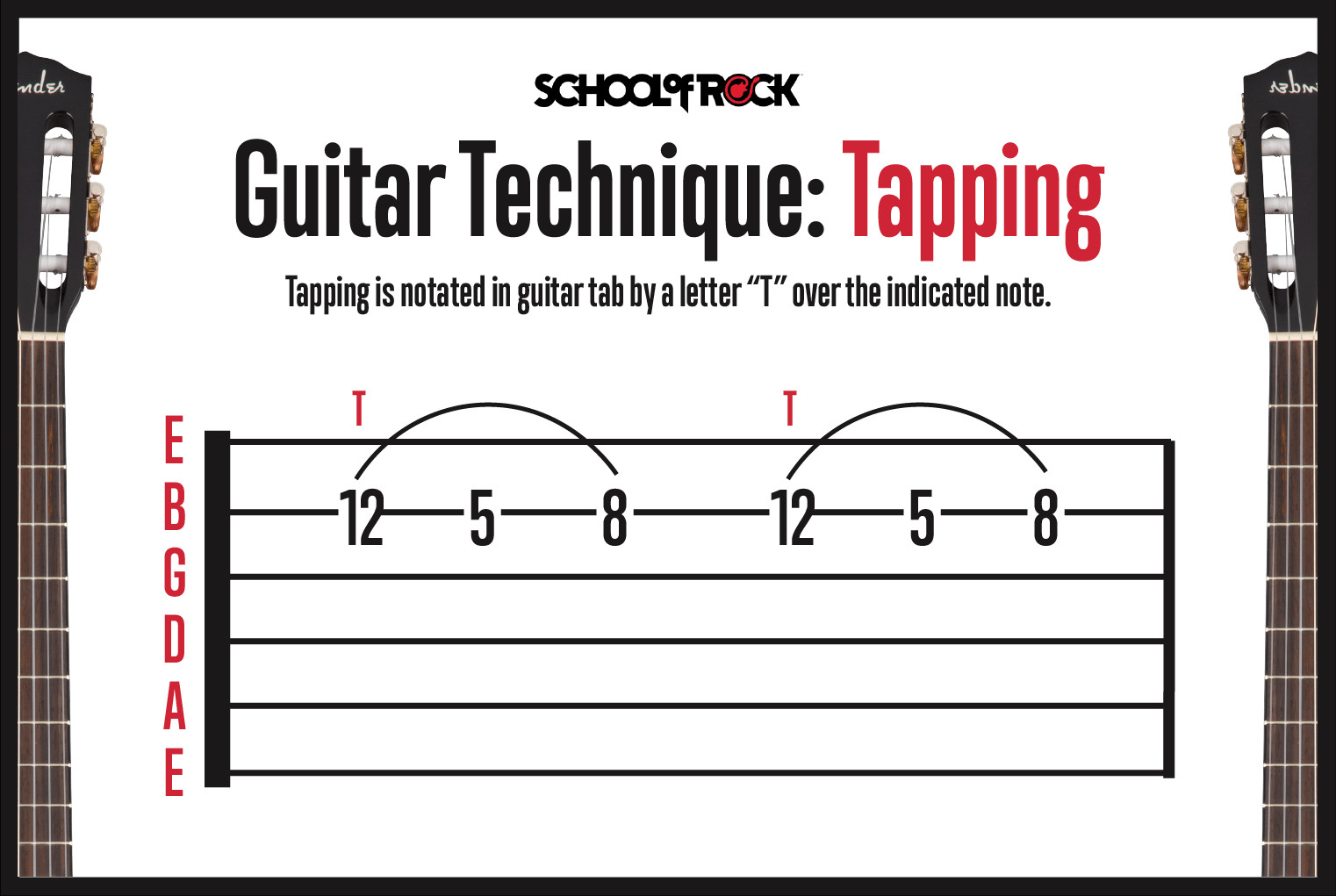 Guitar technique tapping notes. Tapping is often indicated by the letter "T" above the note being tapped
Guitar technique tapping notes. Tapping is often indicated by the letter "T" above the note being tapped
24. How Do You Combine Guitar Tabs With Other Learning Resources?
To maximize your learning, combine guitar tabs with other resources like video lessons, chord charts, and music theory books. Video lessons can show you proper technique, chord charts can help you understand chord progressions, and music theory can give you a deeper understanding of how music works.
Combining guitar tabs with other learning resources is an effective way to become a well-rounded guitarist.
- Video Lessons: Provide visual demonstrations of techniques.
- Chord Charts: Help you understand chord progressions.
- Music Theory Books: Give you a deeper understanding of how music works.
- Online Communities: Join online communities for support and guidance.
- Personalized Instruction: Consider private lessons for personalized instruction.
25. How Can You Create Your Own Guitar Tabs?
You can create your own guitar tabs using a text editor or specialized tab editing software. Listen to the song you want to tab, identify the notes, and write them down in the correct format, with the lines representing the strings and the numbers representing the frets.
Creating your own guitar tabs is a great way to deepen your understanding of music and guitar playing.
- Text Editor/Software: Use a text editor or specialized tab editing software.
- Listen and Identify Notes: Listen to the song and identify the notes.
- Correct Format: Write the notes in the correct format with lines and numbers.
- Accuracy: Ensure accuracy by double-checking your work.
- Share Your Tabs: Share your tabs with others to get feedback and help them learn.
26. What Are Some Advanced Techniques That Can Be Learned Through Guitar Tabs?
Advanced techniques that can be learned through guitar tabs include sweep picking, tremolo picking, alternate picking, pinch harmonics, and legato playing. These techniques require practice and a solid understanding of the basics.
Learning advanced techniques through guitar tabs can take your playing to the next level and allow you to play complex and impressive solos.
- Sweep Picking: A technique involving a sweeping motion across multiple strings.
- Tremolo Picking: Rapidly picking a single note.
- Alternate Picking: Alternating between upstrokes and downstrokes on each note.
- Pinch Harmonics: Creating artificial harmonics by pinching the string with the pick.
- Legato Playing: Playing notes smoothly and connectedly.
27. What Are the Benefits of Joining a Guitar Community for Learning Tabs?
Joining a guitar community provides support, feedback, and inspiration for learning tabs. You can ask questions, share your progress, and learn from more experienced players. Additionally, communities often share tabs and resources that can be helpful.
Being part of a guitar community can greatly enhance your learning experience and help you stay motivated.
- Support and Feedback: Get support and feedback from other guitarists.
- Inspiration: Find inspiration from other players’ progress.
- Ask Questions: Ask questions and get answers from experienced players.
- Share Progress: Share your progress and celebrate your achievements.
- Resources: Access shared tabs and resources.
28. How Can You Improve Your Speed and Accuracy When Reading Guitar Tabs?
To improve speed and accuracy, practice regularly with a metronome, focus on accuracy over speed, and gradually increase the tempo. Also, break down complex passages into smaller sections and practice them repeatedly until you can play them flawlessly.
Improving speed and accuracy is essential for playing guitar tabs smoothly and confidently.
- Regular Practice: Practice reading tabs regularly.
- Metronome: Use a metronome to improve your timing.
- Accuracy First: Focus on accuracy before speed.
- Gradual Tempo Increase: Gradually increase the tempo as you become more comfortable.
- Break Down Passages: Break down complex passages into smaller sections.
29. What Role Does Ear Training Play in Learning Guitar Tabs?
Ear training helps you recognize notes and chords by ear, which can greatly enhance your ability to read and play guitar tabs. If you can recognize the notes and chords in a song, you’ll be able to read the tabs more quickly and accurately.
Ear training is a valuable skill for any musician, and it can be particularly helpful for learning guitar tabs.
- Recognize Notes and Chords: Helps you recognize notes and chords by ear.
- Quick and Accurate Reading: Enhances your ability to read tabs quickly and accurately.
- Transcribing Music: Improves your ability to transcribe music by ear.
- Improvisation: Develops your improvisation skills.
30. How Can You Stay Motivated When Learning Guitar Tabs?
To stay motivated, set realistic goals, choose songs you enjoy playing, and track your progress. Also, find a practice partner or join a guitar community to share your journey and get support.
Staying motivated is essential for long-term success in learning guitar tabs.
- Set Realistic Goals: Set achievable goals to maintain momentum.
- Enjoyable Songs: Choose songs you enjoy playing.
- Track Progress: Monitor your progress to see how far you’ve come.
- Practice Partner/Community: Find a practice partner or join a guitar community.
- Reward Yourself: Reward yourself for achieving milestones.
Embarking on your electric guitar journey with tabs is an exciting endeavor, and guitarplayers.net is here to support you every step of the way. With our comprehensive resources, from beginner lessons to advanced techniques, you’ll find everything you need to master the art of playing guitar. Join our community today and start turning your musical dreams into reality!
Ready to dive deeper? Explore our lessons, discover new tabs, and connect with fellow guitar enthusiasts at guitarplayers.net.
Address: 1140 Boylston Street, Boston, MA 02215, United States.
Phone: +1 (617) 747-2261.
Website: guitarplayers.net.
FAQ About Learning Guitar Tabs on Electric Guitar
-
Q1: Is it necessary to learn standard music notation to play guitar tabs?
No, it is not necessary. Guitar tabs are designed to be a simplified method of reading music for guitar, and many guitarists learn to play proficiently using tabs alone.
-
Q2: How long does it take to become proficient at reading guitar tabs?
Proficiency varies, but with consistent practice, beginners can start playing simple songs within a few weeks.
-
Q3: Can guitar tabs be used for all genres of music?
Yes, guitar tabs can be used for virtually any genre of music, including rock, pop, blues, classical, and more.
-
Q4: Are there any apps or software that can help with learning guitar tabs?
Yes, there are many apps and software programs available, such as Guitar Pro, Songsterr, and Ultimate Guitar, that can assist with learning guitar tabs.
-
Q5: How do you handle complex rhythms in guitar tabs?
Complex rhythms are best learned by listening to the song and using rhythmic notation provided in some tabs, or by using standard music notation in conjunction with tabs.
-
Q6: What should I do if I find a mistake in a guitar tab?
If you find a mistake, cross-reference the tab with other versions or listen closely to the song to correct the error.
-
Q7: Can I learn to improvise using guitar tabs?
While tabs primarily show you how to play specific songs, understanding the underlying scales and chord progressions in the tabs can help you learn to improvise.
-
Q8: How important is it to learn guitar techniques like bending and vibrato?
Learning techniques like bending and vibrato is essential for adding expression and authenticity to your guitar playing.
-
Q9: How do you read guitar tabs for acoustic guitar versus electric guitar?
The method for reading guitar tabs is the same for both acoustic and electric guitar. The tabs indicate the same fret and string positions regardless of the guitar type.
-
Q10: What are the best ways to improve my finger dexterity for playing guitar tabs?
Regular practice, finger exercises, and playing scales and arpeggios can improve your finger dexterity for playing guitar tabs.

